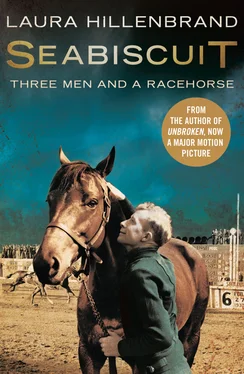But the weight maximums were so low that near fasting and water deprivation weren’t enough. Even what little water and calories the body had taken in had to be eliminated. Many riders were “heavers,” poking their fingers down their throats to vomit up their meals. Others chewed gum to trigger salivation; Tommy Luther could spit off as much as half a pound in a few hours. Then there were the sweating rituals, topped by “ road work.” This practice, used by both Red Pollard and George Woolf, involved donning heavy underwear, zipping into a rubber suit, swaddling in hooded winter gear and woolen horse blankets, then running around and around the track, preferably under a blistering summer sun. Stephens remembered seeing jockeys in full road-work attire gathering at a bowling alley, so lathered that sweat spouted from their shoes with each step. After road work, there were Turkish baths, where jockeys congregated for mornings of communal sweating. The desiccation practices of jockeys were lampooned by turf writer Joe H. Palmer in a column written on jockey Abelardo DeLara: “ DeLarahas to sweat off about two pounds a day to make weight. Last year, by his own estimate, he lost about 600 pounds this way. Since he weighs about 110, it is a mere matter of arithmetic that he would be a bit more than 700 pounds if he hadn’t reduced so regularly.”
Most jockeys ingested every manner of laxative to purge their systems of food and water. Diarrhea became the constant companion of many riders, some of whom became virtuosos of defecation. Helen Luther once watched a rider step on a scale, only to see that he was over his horse’s assigned impost. He shouted to the clerk of scales to hang on, raced to the bathroom, emerged a moment later with his pants still at half mast, and made weight. Such results could be had from a variety of products, including a stomach-turning mix of Epsom salts and water—chased by two fingers of rye to stop the gagging reflex—a plant-derived purgative called jalap, or bottles of a wretched-tasting formula known as Pluto Water.
But the undisputed champ of the purgatives was born in the enterprising mind of a jockey’s masseur named Frank “Frenchy” Hawley. Prowling around the Tijuana jockeys’ room in reassuringly medical-looking Dr. Kildare attire, Frenchy was the self-appointed mad scientist of the racing world. Operating out of a gleaming-white training room, Frenchy stocked every manner of weight-loss facilitator, including electric blankets, infrared lamps, electric light cabinets, baking machines, “violet-rays,” vibrating contraptions, and rubber sleeping bags and sheets. He also dreamed up a particularly foul-smelling recipe for self-parboiling that required riders to steep for up to thirty-five minutes (fewer if they became dizzy) in piping-hot water mixed with three to five pounds of Epsom salts, one quart of white vinegar, two ounces of household ammonia, and a mystery lather he called Hawley’s Cream. He kept careful records of the weight he had stripped from riders. By 1945, it totaled 12,860 pounds—more than six tons.
One of Frenchy’s cardinal rules of reducing was to “keep the contents of the bowels moving down and out steadily and regularly.” To devise a mix that would bring this about, he tinkered around with God knows what until he stumbled upon a home brew that delivered a ferocious kick. The caustic laxative worked so well that Hawley marketed it commercially under the disarmingly innocuous name Slim Jim. Former jockey Bill Buck remembered it with a shiver: “It’d kill you.” He wasn’t kidding. Frenchy’s bowel scourer proved to be so fabulously potent that bottles of it spontaneously exploded in the jockeys’ room lavatory. Imagining their intestines going out in a similar blaze of glory, even the jockeys began to fear it, and Hawley’s Slim Jim experiment went down the tubes.
For jockeys who were truly desperate, there was one last resort. Contact the right people, and you could get hold of a special capsule, a simple pill guaranteed to take off all the weight you wanted. In it was the egg of a tapeworm. Within a short while the parasite would attach to a man’s intestines and slowly suck the nutrients out of him. The pounds would peel away like magic. When the host jockey became too malnourished, he could check into a hospital to have the worm removed, then return to the track and swallow a new pill. Red Pollard may have resorted to this solution.
In denying their bodies the most basic necessities, jockeys demonstrated incredible fortitude. They paid a fearsome price. Most walked around in a state of critical dehydration and malnutrition and as a result were irritable, volatile, light-headed, bleary, nauseated, gaunt, and crampy. The heavers, exposing their mouths to repeated onslaughts of stomach acid, lost the enamel on their teeth and eventually the teeth themselves. Other jockeys suffered bouts of weakness so severe that when boosted into the saddle they would fall right off the other side. Dehydration left them so prone to overheating, even in mild weather, that their valets prepared huge bins of ice cubes into which they could flop to cool off. Other riders suffered fainting spells or hallucinated.
Many jockeys’ bodies could not function under the strain. To take off enough weight to ride a horse in Windsor, Canada, Sonny Greenberg steamed in a Turkish bath, guzzled Epsom salts mixed with jalap, took a boat from Detroit to Windsor—vomiting all the way—donned a rubber suit over several layers of heavy clothing, and ran around and around the track. He staggered into the woods, collapsed, and either fell asleep or fainted. He awoke in a pool of sweat, and tried to clear his disorientation by downing a half-ounce of whiskey. Dragging himself to a scale, he found that he had suffered away ten and a half pounds in one night. It was all for naught. By post time he was too weak even to sit upright in a saddle. He gave someone else the mount, and retired soon afterward.
Greenberg escaped without permanent damage, but others, including Fitzsimmons, may not have been so lucky. Severe reducing was thought to be the culprit behind an epidemic of fatal lung diseases, such as pneumonia and tuberculosis, among jockeys. Other long-term health problems may also have stemmed from reducing practices. In a single day, to make weight on a horse, Fitzsimmons endured purgatives, an entire afternoon in a Turkish bath, heavy exercise on horseback and on foot while swaddled in several sweaters and a muffler, topped off with an hour standing inches from a roaring brick kiln. He lost thirteen pounds. Thick-tongued and groggy, he won the race by a nose but couldn’t repeat the weight-loss performance and retired from the saddle not much later. He soon experienced the first shooting pains from the severe arthritis that would grotesquely disfigure his body. He came to believe that that one terrible day of reducing may have triggered the onset of the crippling disease.
Finally, there was the mental toll. Stephens described his realization that he could no longer take the punishment of reducing as “the biggest disappointment of my life.” The legendary nineteenth-century European jockey Fred Archer understood the emotion. Falling into a severe depression attributed to his taking constant doses of purgatives to fight a weight problem he could not beat, he shot himself to death at age twenty-nine.
A Thoroughbred racehorse is one of God’s most impressive engines. Tipping the scales at up to 1,450 pounds, he can sustain speeds of forty miles per hour. Equipped with reflexes much faster than those of the most quick-wired man, he swoops over as much as twenty-eight feet of earth in a single stride, and corners on a dime. His body is a paradox of mass and lightness, crafted to slip through air with the ease of an arrow. His mind is impressed with a single command: run. He pursues speed with superlative courage, pushing beyond defeat, beyond exhaustion, sometimes beyond the structural limits of bone and sinew. In flight, he is nature’s ultimate wedding of form and purpose.
Читать дальше











